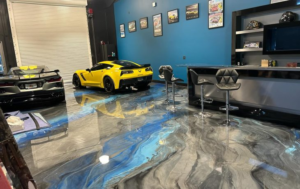Is Wall Texture Better Than Flat Paint? What Melbourne Homeowners Prefer

Choosing the right wall finish is one of the most important decisions when renovating or redecorating a home. Flat paint offers a clean, classic look, while textured walls can add depth and style to any room. For Melbourne homeowners, deciding between wall texture and flat paint often comes down to personal taste, practicality, and long-term maintenance.
This guide explains the options, pros and cons, and where each finish works best.
Popular Wall Texture Types in Melbourne Homes
Textured walls have evolved beyond the simple patterns of the past. Modern finishes include:
- Sponged Wall Texture: Subtle, artistic patterns created with a sponge technique. Adds depth without being overwhelming.
- Knockdown Texture: Popular in living rooms and bedrooms, it creates a soft, dappled effect.
- Venetian Plaster or Decorative Painting: High-end, polished finish for feature walls or statement areas.
- Stucco or Textured Coatings: Durable, often used in wet areas or high-traffic zones.
Each type offers a distinct visual effect, and the choice depends on the room’s purpose, lighting, and overall design style.
Flat Paint: The Classic Choice
Flat paint remains a favourite for many Melbourne homes. It is:
- Simple and Clean: Provides a smooth, uniform surface that works with any décor.
- Cost-Effective: Generally less expensive than textured finishes.
- Easy to Maintain: Touch-ups blend easily.
- Versatile: Suitable for ceilings, hallways, and rooms where subtlety is preferred.
Flat paint is ideal if you want a minimalist, modern look or plan frequent colour changes.
Pros of Wall Texture
Adding texture has several advantages:
- Hides Imperfections: Minor wall cracks, bumps, or uneven surfaces are less noticeable.
- Adds Visual Interest: Creates a sense of depth and sophistication, especially on feature walls.
- Customisable Styles: Patterns and techniques can be tailored to suit traditional or modern homes.
- Enhanced Durability: Some textured coatings resist wear better than standard flat paint.
Textured walls are particularly useful in living rooms, dining areas, or any space where you want the walls to make a statement.
Cons of Wall Texture
While textures can enhance style, there are considerations:
- More Expensive: Textured finishes require additional materials and labour.
- Difficult to Change: Repainting or switching to a flat finish often requires sanding or skim coating.
- Cleaning Challenges: Some textured surfaces collect dust more easily than flat walls.
- Lighting Effects: Heavy textures can cast shadows or affect natural light in smaller rooms.
Understanding these limitations helps homeowners make informed decisions about where textures work best.
Pros of Flat Paint
Flat paint also has clear benefits:
- Cost and Time Efficient: Less preparation and application time than textured finishes.
- Flexible Design: Easy to repaint for seasonal colour updates.
- Smooth Surface: Ideal for modern, minimalist designs and small rooms.
- Low Maintenance: Easy to wipe and clean, depending on the paint type.
Flat paint is practical for high-traffic areas like hallways, kitchens, and bathrooms where simple surfaces are preferred.
Where to Use Textured Walls vs Flat Paint
Choosing between texture and flat paint often comes down to the room’s function and desired aesthetic.
Best Areas for Textured Walls:
- Feature walls in living rooms or dining areas
- Accent walls behind beds or fireplaces
- Rooms with minimal furniture to highlight wall design
Best Areas for Flat Paint:
- Ceilings and corridors for a seamless look
- Kitchens and bathrooms for easy cleaning
- Rooms with bold décor where wall texture may compete with other elements
A common approach is to combine both: textured finishes for accent walls and flat paint for general coverage.
Maintenance and Longevity Considerations
Flat paint is easier to maintain but may show minor imperfections over time. Textured walls can hide small flaws but can be harder to clean. Choosing high-quality paints and coatings is essential. Many Melbourne homeowners rely on professional painters for consistent results and long-lasting finishes.
Professional Services: Teams like Paintpal provide advice on which finish suits your home, ensuring surfaces are properly prepped and painted. They help combine textures and flat finishes for a cohesive interior look, avoiding common DIY pitfalls.
2025 Trends for Melbourne Interiors
This year, homeowners are favouring:
- Subtle textures with neutral tones for living rooms
- Matte flat paint for bedrooms and minimalist interiors
- Decorative plaster or faux finishes for feature walls
- Combining soft textures with bold colours to create modern, layered designs
Keeping up with trends helps maintain home value while creating a personalised space.
Making the Decision
When deciding between wall texture and flat paint, consider:
- Room Function: Flat paint for practical areas, texture for visual impact.
- Budget: Textures cost more in materials and labour.
- Maintenance: Flat paint is easier to clean and touch up.
- Design Goals: Do you want subtlety or a statement wall?
Many homeowners opt for a balance: a textured feature wall combined with flat painted surroundings for versatility and style.
Final Thoughts
Wall texture and flat paint each have advantages. Flat paint offers simplicity and practicality, while textured finishes add character and can disguise minor imperfections. Melbourne homeowners should evaluate their design goals, room usage, and budget before choosing a finish.
Professional painters like Paintpal can guide homeowners through the decision-making process, ensuring surfaces are prepped correctly and finishes are durable. Subtle textures paired with quality paint can transform interiors while keeping maintenance manageable.
Frequently Asked Questions
1. Is textured wall painting more expensive than flat paint?
Yes. Textured finishes require more preparation, specialised tools, and multiple coats, which increases cost compared to flat paint.
2. Can I repaint textured walls to flat paint later?
It is possible but requires surface preparation such as sanding or skim coating to achieve a smooth finish.
3. Which rooms are best suited for wall texture?
Living rooms, dining areas, and feature walls benefit most from textured finishes. Accent walls add depth without overwhelming the space.
4. How easy is it to clean textured walls?
Cleaning depends on the texture type. Subtle patterns are easier to wipe down, while heavier textures can trap dust and require gentle cleaning.
5. Should I hire professional painters for textured walls?
Yes. Professionals ensure even application, proper preparation, and a high-quality finish that lasts longer than DIY attempts.






